How to Grow Clematis
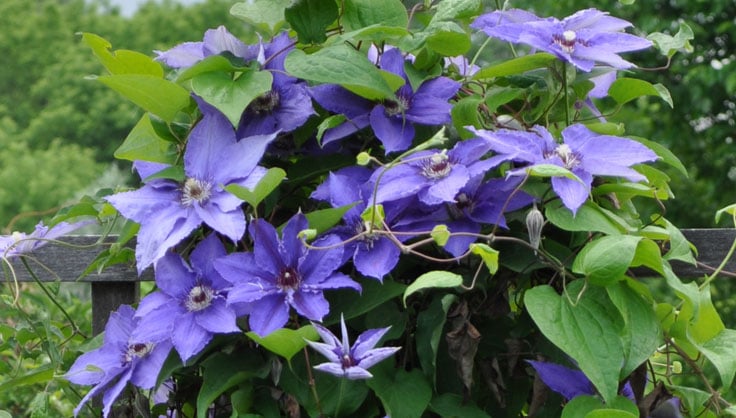 A clematis in full flower is a sight to behold.
A clematis in full flower is a sight to behold.Clematis flowers are beloved for their stunning blooms and ability to add vertical interest to gardens. New to clematis? Read on and discover how easy it is to be successful with the "queen of climbers."
Choosing the Right Variety of Clematis
When selecting a clematis for your garden, you'll want to think about a couple things, which include its mature height, flowering time, and preferred planting conditions. Popular cultivars include 'Nelly Moser,' 'Jackmanii,' and 'Henryi,' each offering unique characteristics to suit different tastes and landscapes.
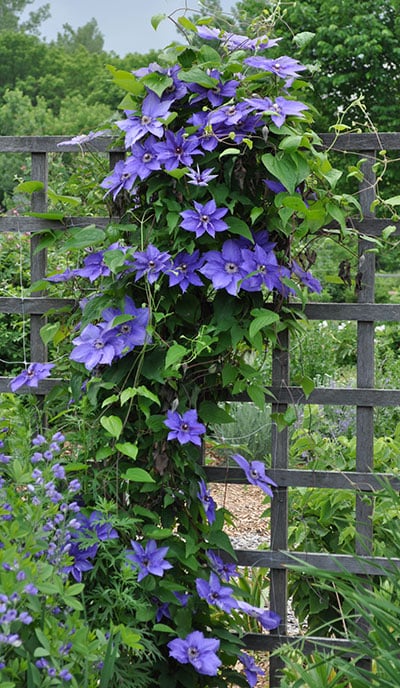
If you have room for a vigorous 10- or 20-foot clematis vine, there are many wonderful cultivars that will fit the bill. There are also more compact varieties that are perfectly happy growing in a small garden or even in a pot on the patio. The standard clematis flower form is a large blossom with six or seven petals, measuring 5-6" across. There are also cultivars with smaller blossoms, double blossoms, and lovely bell-like flowers. Colors range from white to wine red, lavender to deep purple, and there are even a few yellow ones.
It can take several years for a clematis vine to mature and begin flowering vigorously.1 To shorten the wait and help ensure your success, it's best to purchase a plant that's at least two years old. Look for a container-grown plant in a quart or gallon-size pot. If you're shopping for your clematis at a garden center or nursery, select a robust plant that's showing vigorous growth, rather than a weak plant with a beautiful picture.
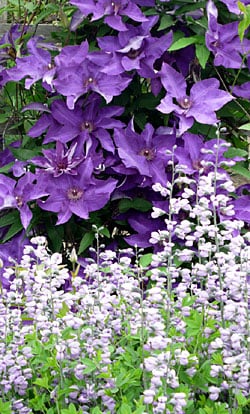 Companion plants, such as this pale-purple baptisia, keep the clematis' root-zone cool.
Companion plants, such as this pale-purple baptisia, keep the clematis' root-zone cool.Selecting the Ideal Location for Clematis
Though some clematis cultivars will bloom in partial shade (such as 'Nellie Moser' and 'Henryii'), most clematis varieties thrive in locations that provide ample sunlight, preferably six hours or more per day. Well-draining soil enriched with organic matter is also essential. Clematis prefer moist, well-drained soil that's neutral to slightly alkaline in pH.2 If your soil tends to be acidic, you should sweeten it periodically with limestone or a little wood ash. Before planting, ensure the area has sufficient space for the vine to grow, and consider providing a sturdy trellis or support structure for the plant to climb.
How to Plant and Care for Clematis
The best time to plant clematis is during the early spring or fall.3 Prepare the soil by loosening it and adding compost, granular organic fertilizer, or well-rotted manure. Dig a hole twice the size of the root ball and loosen the soil 2' around and below the hole. Then gently place the clematis in the hole. Position the plant slightly deeper than it was growing in the pot, so the first set of true leaves is just under the soil surface. Backfill with the native soil.
Water thoroughly and provide initial care to help the plant establish a strong root system. Water weekly for the first season, to help the plant get established. If you can get your clematis through its first year, chances are good that it will continue to thrive. Mulching around the base of the plant will help conserve moisture. Clematis are happiest with cool shade at their roots and warm sun on their foliage — mulching around the roots will help keep the soil cool, as will the foliage of a low-growing perennial placed in front of this vine.
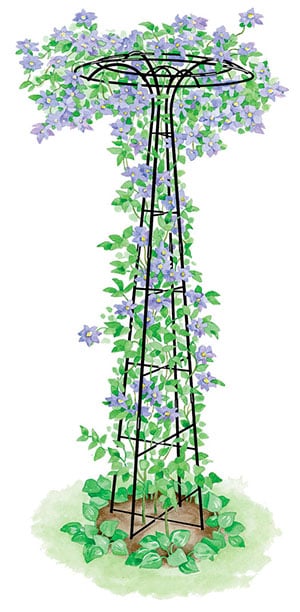 Vines grow up and over the top of the Essex Tuteur, and then drape gracefully.
Vines grow up and over the top of the Essex Tuteur, and then drape gracefully.Supporting and Training Clematis
Provide a sturdy support structure such as a trellis, arbor, or fence for clematis to climb. Secure the vine to the support system with ties or clips, allowing it room to grow and spread. Regularly check and adjust the supports to prevent damage from strong winds or heavy rain. Althtough there are some types of clematis that have a bushy habit, most of them are born to climb. Like other climbing plants, the growing end of a clematis vine is searching for something to grab onto, and if it can't find anything, it will stop growing. Make sure you provide it with something to climb on from day one.4
A clematis vine does not climb by twining around something, as a pole bean or a morning glory does. It climbs by wrapping its leaf stems around something. Because these leaf stems are not very long, anything that's more than about 1/2" in diameter is too wide for the leaf stem to twist around. The easiest things for a clematis to grab onto are twine, fishing line, wire, thin branches, wooden dowels, or steel rods. The more grabbing opportunities you offer the better, so even if you have a nice trellis, consider adding some twine "helper" lines, or covering your trellis with a grid of trellis netting.
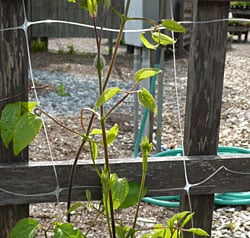 Nearly Invisible Netting ensures that a clematis can climb a trellis with wide crosspieces.
Nearly Invisible Netting ensures that a clematis can climb a trellis with wide crosspieces.Pruning Techniques for Clematis
Understanding the pruning groups of clematis is vital for proper care.5 Group 1 clematis blooms on old wood and requires minimal pruning, while Group 2 and Group 3 bloom on new wood and benefit from more extensive pruning. Rather than driving yourself crazy trying to keep track of the ideal pruning technique for each cultivar, try this common-sense approach: leave the prior year's growth in place until mid-spring. Begin pruning only when you can see which vines are dead and which ones are starting to leaf out.
Clematis Growing FAQs
- What is the best way to plant clematis?
Dig a hole twice the size of the root ball, loosen the soil 2' around and below your hole, and prepare the hole with compost and fertilizer (ideal pH of 6.5-7). If planting multiple clematis, plant them 2-3 feet apart give them room to grow. Ensure they'll get about 6 hours of sun in the location you choose. - When should I plant clematis?
The best time to plant clematis is in early spring or in the fall. This gives the plants time to acclimate and set down roots before they have to weather the heat of summer or the cold of winter. - How much water do clematis need?
Clematis need to be watered once a week, during drought or dry weather they should be watered deeply each week. Be careful not to get the foilage wet as this can cause disease and fungus. - How should I prune my clematis?
Pruning clematis should be done in early spring, but what to cut back depends on the group of clematis it is. Group 1 should only be pruned to remove dead leaves, flowers and branches. With Group 2 and Group 3 clematis pruning your plants to 12-18" above the soil will help promote growth through the coming season.
Sources
1https://www.thespruce.com/clematis-care-guide-75068322https://ag.umass.edu/home-lawn-garden/fact-sheets/clematis
3https://www.rhs.org.uk/plants/clematis/growing-guide
4https://extension.oregonstate.edu/news/clematis-climb-special-place-garden
5https://extension.psu.edu/clematis-queen-of-the-vines
Print this Article:
Get the Dirt
Stay up to date on new articles and advice. Please fill out the information below.


